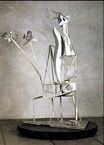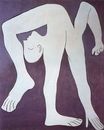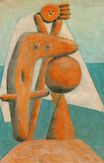©Пабло Пикассо - Акробат 1930
 |
 |
 |
 |
 |
 |
 |

Акробат 1930
69x59см масло/панель
Museum Picasso, Paris, France
The image is only being used for informational and educational purposes
<< Previous G a l l e r y Next >>
From Museo Picasso Málaga:
The original inspiration for Picasso’s Acrobat series may have been the Médrano circus, but they also evolved from the drawings of dancers that he made in 1924 and 1925. During the winter of 1929–30, the circular pattern of the pas de deux became a series of multiple silhouettes in slow motion, by turn acrobat and warrior with shield and dagger. In the same way, the fanciful arrangement of the present work – without a central body, face against buttock, right leg stretched out and left leg folded, the two arms firmly parallel – presents the figure in an endless turning movement, and in addition seems to suggest that the work itself could be rotated: the picture can in fact be turned and viewed from all four sides. This rare quality, also evident in two later drawings and confirmed by the presence of two women acrobats together on the same canvas, depicted in The Painter of 20 January, harks back once again to Egyptian art, which was for Picasso ‘a living art’, where the decoration is visually enriching, without the need for written explanation. Contained within a thick black outline and rapidly applied, the light and airy white of the figure contrasts with the thick grey background – a tension that accentuates the effect of weightlessness of the Female Acrobat, while the traces of alterations and the texture of the wooden panel visible through the layer of white enhance the dynamic vitality of the work.